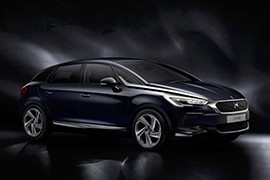DS AUTOMOBILES DS 5 Models/Series Timeline, Specifications & Photos
First production year: 2016
Engines: Diesel, Gasoline, Hybrid diesel
DS Automobiles introduced the DS5 in 2016 as its flagship model, and it was a mix between a minivan and an executive vehicle, all within the same footprint as a compact vehicle, suitable for the urban environment.
Citroen introduced the DS5 in 2011 as part of its upscale models lineup. It looked different than any other vehicle produced by the French automaker since it was a mix between an executive and a compact hatchback. Fast forward to 2016, and the DS range became part of the DS Automobiles premium brand, owned by PSA (Peugeot-Citroen). As a result, all the models that featured these two letters in their nameplates ditched the “double-chevron” badge from them and adopted the DS logo. Furthermore, after being upgraded and rebadged, they could compete with the best in business and edged some of them. The DS5 had no competitors since it was a premium minivan/hatchback with unique features. On top of that, it looked like a concept car, even though it was a production vehicle.
The 2016 DS5 had a new front fascia that featured a grille adorned by a 3D mesh design where the DS logo took center stage. It was surrounded by a chromed trim and flanked by full Xenon LED headlights. Lower, on the bumper, the automaker added a second air intake flanked by a pair of round fog lamps and a set of vertically mounted LED daytime running lights. Above the front fascia, the hood showed a distinct look with its longitudinal dome, which resembled a longitudinally mounted engine, even though it had been positioned transversely.
From its profile, the DS5 kept its original, minivan-like profile. But it looked more upscale than before thanks to the specific details, such as the chromed trims that flanked the hood and were extended towards the A-pillars. The door mirrors were mounted more rearward than most common vehicles due to the triangular window installed between the doors and the windshield. In addition, the slightly descending roofline towards the car’s back created a dynamic image for the vehicle. At the same time, the floating-roof styling resembled the one introduced by the car’s smaller brother, the DS 3.
Inside, DS Automobiles installed high-quality materials and emphasized that with an upscale-level fit and finish. Furthermore, the door handles, for instance, were made from aluminum, not plastic. The automaker tried to create a cockpit-like environment. It was emphasized by an upper console featuring a few buttons controlling the sun shades for the four roof-mounted glass areas and the available head-up display screen. Fronting the driver was an instrument cluster where the speedometer took center stage and was flanked by a digital tachometer on the left and a screen for the car’s onboard computer on the right. The fuel level and the coolant temperature gauges were digital and installed inside the speedometer’s round arch. A tall center console separated the front bucket seats and housed the gear stick, armrest, and other buttons. In the back, a 60/40 split-folding bench seat could accommodate three adults.
DS Automobiles built the DS5 on the same PF2 platform used by the Citroen C4 Picasso and the first generation of the Peugeot 3008 crossover. The automaker offered the car with a choice of diesel, gasoline, or hybrid drivetrains paired with either a six-speed manual or a six-speed automatic. The 200 PS (197 hp) hybrid version was the only one available with an all-wheel drive system, where an electric motor powered the rear wheels. All the other engine versions sent their power to the front wheels only.
